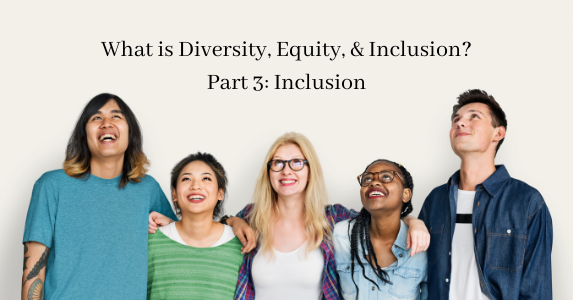What is Diversity, Equity, & Inclusion? Part 3: Inclusion
November 20, 2020

What is Inclusion? The word diversity has been used to describe the industry for a long time but the word inclusion was added to emphasize that simply having diversity doesn’t mean leveraging diversity. Why would a company seek diversity and not be inclusive? There are many reasons why diversity doesn’t lead to inclusion ranging from outright discrimination to corporate culture. As such, the word inclusion was specifically called out to coach the world that diversity in and of itself does not foster inclusion. Here are three important components of inclusion:
Inclusion is Incorporation
When we include, we incorporate. This means that the people we have lead the process versus the process leading them. Policies, practices, and procedures are all well and good, but they mean nothing if people don’t adopt them and take ownership of them. One of the biggest issues in diversity is being on the team but not being incorporated in the process. Reasons companies and organizations give for not incorporating more people in the decision-making process include: that it will take too much time, that too many cooks in the kitchen spoil the soup, and decision making by committee is ineffective. The reality is decisions do need to be made in a timely manner and generally, only one person can be the head chef. However, getting more input by incorporating more people could be part of the process if different voices are important to your organization. Incorporation is the first step of inclusion. It is simply an invitation to the table. It is providing access to previously closed rooms and discussions.
Inclusion is Involvement
The second step of inclusion is involvement. There is an important distinction between incorporation and involvement. While incorporation can look like involvement, involvement is a bit different. As stated above, incorporation is being invited to the table while involvement is being asked to help plan the meal, attend the dinner, and actually get to dine. Not all people will get to do all things but having diversity at different levels and including that diversity in the process is not enough. When the menu is being planned and the lone woman on the executive team is invited to the discussion with the expectation that she should go along, that is not involvement. She may be incorporated in the process and that particular meeting, but real involvement requires her input. Real involvement requires the ability to express opinions and alternatives that are designed to make the final decision better. If we are not challenging thought, we are not truly involved in the construction of a better solution. We have all been in meetings where we were invited to observe but not speak. Then exactly why are we there? Involvement requires active participation. A positive by-product of involvement is that it bolsters ownership. People who are expected to actively participate are compelled to take greater ownership in what they are doing. When individuals are respected in a way that fosters involvement, the entire organization flourishes.
Inclusion is Intentional
Inclusion doesn’t just happen. It has to be part of the culture. Leaders at all levels must be intentional about inclusion. It bears repeating, diversity is not inclusion. Diversity is representation where inclusion is participation. Companies should avoid representation without participation. At worst it presents like tokenism and at best, it is disrespectful. When an individual feels like the token, that individual is always second-guessing their value and effectiveness. This is in part due to the fact many of that individual’s coworkers see them as a token versus just another valued member of the team. When an individual feels disrespected, that individual is consistently working to earn that respect or may even be discouraged which prevents them from being their best. When we are intentional about inclusion we signal we value participation. We say to our coworkers and teammates that we truly believe their contributions will make us better. Great leaders welcome opposing views because those views either help improve the final solution or strengthen the rationale for going in an opposing direction. When you are intentional about inclusion you seek perspectives that are not typically in the room and become deliberate in showcasing them.
Inclusion requires the incorporation of different people as well as the real involvement of those people but wishing for it to happen without a plan is pure folly. Inclusion is intentional.
Written by: Reggie Ponder


